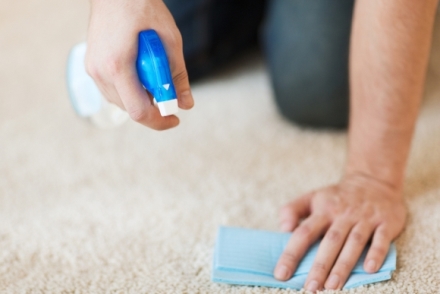We all know carpet is tough to clean, even if it’s just an innocent drink spill. It is estimated that on average over 51% buildings are carpeted, which is why it’s important to know how to deal with spills, especially in the unfortunate situation when it involves a biohazard like blood or other bodily fluids.

Should a spill occur, the two questions you must ask yourself are:
How bad is the saturation? What are my risks?
If there’s a lot of blood or other fluid to the point where it causes pooling, the situation is considered serious, as structural damage to the subflooring is possible. In this case, parts of the carpet or even all of it may require removal, as professional remediation is necessary. If the spill is small however, you may decide to do the job yourself. Keep in mind though that even a small amount of blood can lead to bacterial growth, odours and in the future serious health risks in terms of bloodborne pathogens.
All in all, it’s up to you to decide if the amount is significant, and what results you have in mind. If you intend to perform the cleanup yourself (though this is only recommended doing this if it’s minimal), there are a number of procedures you can follow in order to minimise any existing risks.
Always begin by removing any dirt or debris. It’s impossible to clean up a stain if dirt is present, so be sure to remove any solid waste first, and dispose of it properly.
Be quick: blood or other fluids can harden quickly on carpeting, making it tougher to clean. Be sure to respond quickly, and ensure you follow safety precautions like isolating the area from others and wearing the proper personal protective equipment (PPE).
Use the correct cleaning products: Common household products like bleach can damage or destroy your carpet. The most effective way to clean these areas is to use manufacturer approved carpet shampoos and cleaners. Choose a product with anti-microbial properties to help sanitise the area as thoroughly as possible, and then repeat this process another two or three times.
Follow the carpet manufacturer’s directions: Some types of carpet are designed to be more resistant to stains. However, these may need special care in order. Ensure you follow the manufacturer’s directions, alternative cleaning methods can damage the material as well as stain resistant properties.
Consider Steam Cleaning: Steam cleaners will clean and sanitise carpeting more completely than conventional washing. If you’re going to attempt to clean the carpet yourself, this can be a good option, however if you’re renting a steam cleaner, this could indirectly add other bacteria into your home.
If the stain is big enough that you’re considering steam cleaning, it may be more cost effective (and safer) to hire a trusted biohazard cleaning company to thoroughly disinfect the space. Also, many insurance companies will cover all or part of the cost of a cleanup, but check ahead with your agent to ensure you’re covered. A reputable cleaning company can work with you and your provider to make sure you’re getting the service you need.
If you’re ever in need of biohazard cleaning company in East Anglia, contact Monthind Clean, an experienced professional cleaning organisation covering Norfolk, Suffolk and Essex as we’ll take care of your cleanup discreetly and effectively.























